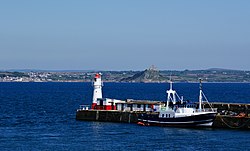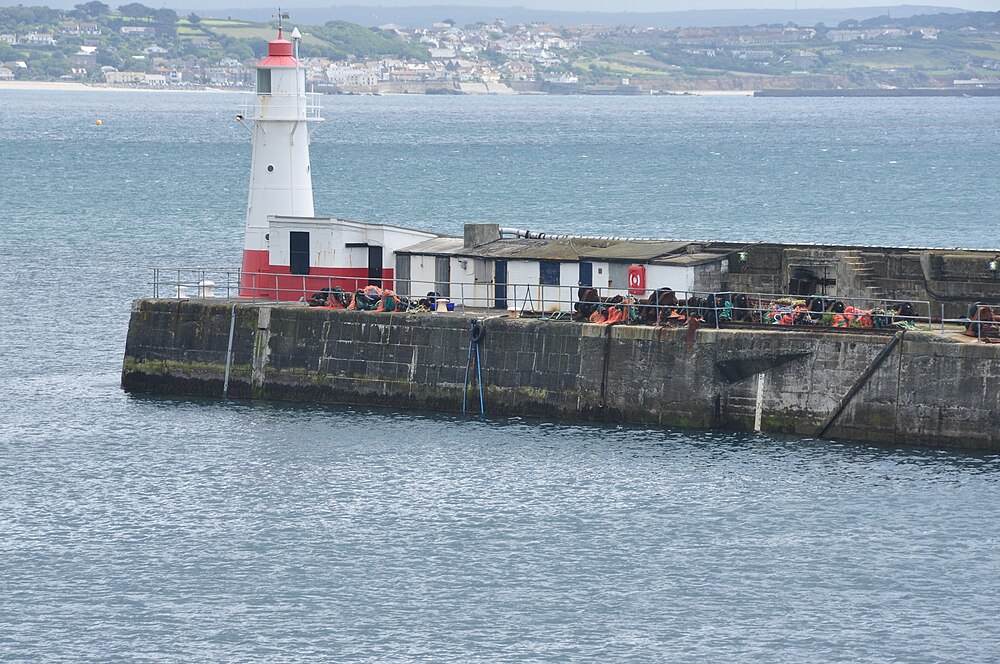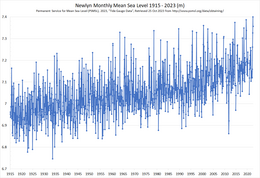| Newlyn Tidal Observatory | |
|---|---|
| GLOSS ID 241 | |
 View of Newlyn Harbour with the lighthouse and Tidal Observatory to its right View of Newlyn Harbour with the lighthouse and Tidal Observatory to its right | |
| Type | Tide gauge |
| Location | Newlyn, Cornwall, England |
| Coordinates | 50°06′11″N 5°32′34″W / 50.103000°N 5.542806°W / 50.103000; -5.542806 |
| Built | 1915 |
| Owner | National Oceanography Centre |
| Website | ntslf |
| Listed Building – Grade II | |
| Official name | Newlyn tidal observatory and part of the south pier |
| Designated | 11 December 2018 |
| Reference no. | 1460225 |
 | |
Newlyn Tidal Observatory is a grade II listed tide gauge hut on the South Pier in Newlyn, Cornwall in England. Measurements of sea level taken at the observatory between 1915 and 1921 were used to define the reference level, Ordnance Datum Newlyn, for height measurement on the British mainland. The tide gauge has collected over 100 years of observations which has significantly contributed to studies in sea level science.
Building and location
The observatory is a building situated behind the lighthouse at the end of the South Pier in Newlyn, near Penzance, in Cornwall. Constructed of concrete, it has the appearance of a small hut and is painted in red and white stripes. Inside the building is an Ordnance Survey benchmark, constituted of a brass bolt (OSBM SW 4676 2855), and a 1.6-metre (5 ft 3 in) diameter stilling well set into the pier which has ocean access via an inlet.
History

 The observatory building in 2011
The observatory building in 2011
The Ordnance Survey established the observatory in 1915 to contribute to the measurement of a national vertical datum defined by mean sea level. The subsequent 6-year measurement campaign at the observatory, conducted from 1 May 1915 to 30 April 1921, determined the value of mean sea level as 4.751 m (15.59 ft) below the level of the brass bolt benchmark inside the hut. Due to the stable underlying granite bedrock, the proximity to the open ocean, and the absence of rivers, the observations at Newlyn were selected as the basis, or ordnance datum, for elevation measurements across Great Britain. To realise the reference datum across the country, in the early twentieth century spirit levelling techniques were used to measure a national network of circa 200 fundamental benchmarks, all referenced to the Newlyn brass bolt.
From 1915 to 1983 the observatory measured sea level using a float in the stilling well, along with a gauge supplied by Cary and Porter. With advances in technology, an Aanderaa pressure gauge was installed in 1981 to operate alongside the well gauge. Since 1983 the primary sensor has been a bubbler pressure gauge.
The Ordnance Survey operated the tide gauge until 1983, when the Natural Environment Research Council took over the management. The observatory was designated as grade II listed status by Historic England in December 2018. As of 2023 the observatory is operated by the National Oceanography Centre, and funding support is contributed by the UK Environment Agency.
Impact

The 6 years of observations captured at the observatory up to 1921 continue to define the height reference system for Great Britain, with varied applications including flood planning, understanding air pollution, infrastructure design, and deliveries by unmanned aerial vehicles.
In 2016 Bradshaw et al. published an article to commemorate 100 years of sea level measurements at the Newlyn observatory, in particular highlighting how the collected data had "played a fundamental role in UK geodesy and oceanography", and in 2021 the impact of the data on ocean and climate change studies was noted.
See also
- Ordnance Survey National Grid – System of geographic grid references used in Great Britain
- Principal Triangulation of Great Britain – 1791–1853 geodetic survey of Britain
- Chart datum – Level of water from which depths displayed on a nautical chart are measured
References
- ^ "Newlyn". National Oceanography Centre. Archived from the original on 3 October 2023. Retrieved 3 October 2023.
- ^ Amos, Jonathan (30 April 2021). "The Cornish hut that gave rise to sea level benchmark". BBC. Archived from the original on 3 October 2023. Retrieved 3 October 2023.
- ^ Bradshaw, E.; Woodworth, P.L.; Hibbert, A.; Bradley, L.J.; Pugh, D.T.; Fane, C.; Bingley, R.M. (18 March 2016). "A Century of Sea Level Measurements at Newlyn, Southwest England". Marine Geodesy. 39 (2): 115–140. Bibcode:2016MarGe..39..115B. doi:10.1080/01490419.2015.1121175. S2CID 131242174.
- "Newlyn Tidal Observatory". Proudman Oceanographic Laboratory. Archived from the original on 14 April 2005.
- "NEWLYN". Permanent Service for Mean Sea Level. Archived from the original on 3 October 2023. Retrieved 8 November 2023.
Documentation added 1991-06-11 Newlyn 170/161 RLR(1964) is 11.7m below TGBM SW4676 2855
- "A Guide to Coordinate Systems in Great Britain" (PDF). Ordnance Survey. pp. 15–16. Archived (PDF) from the original on 24 September 2015. Retrieved 3 October 2023.
- ^ Manning, Jonathan (25 August 2021). "A century ago, scientists in this remote Cornish hut established height zero. Here's why it matters". National Geographic. Archived from the original on 3 October 2023. Retrieved 3 October 2023.
While ODN has proved a priceless reference point for land heights in Britain, it is plays a key role in ocean studies, too
- "Station information". Global Sea Level Observing System. Archived from the original on 28 May 2023. Retrieved 3 October 2023.
1915 – 1984 Float/stilling well 1983 – Bubbler gauge
- "Newlyn tidal observatory and part of the south pier". Historic England. Archived from the original on 3 October 2023. Retrieved 3 October 2023.
- Simons, Paul (1 May 2021). "Newlyn pier plays a crucial role in understanding climate change". The Times. Archived from the original on 3 October 2023. Retrieved 3 October 2023.
Further reading
- Cockram R., L. Holmes, R. Hogg and F. Iddiols. "The Newlyn Tidal Observatory." (2018) ISBN 978-0-9567528-4-0